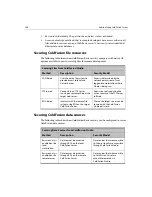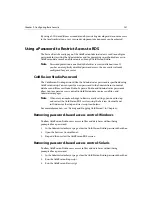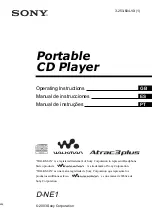
294
Administering ColdFusion Server
Advanced Security Implementations
The four elements discussed in the previous section
— user directories, resources,
policies, and security contexts
— are the building blocks of every type of security
framework you’ll create. You can implement the following types of Advanced Security:
•
User security
— Secures functionality in a ColdFusion application. User
security is implemented in ColdFusion application pages by ColdFusion
developers, and offers runtime user authentication and authorization.
•
Remote Development Services (RDS) security
— Controls a ColdFusion Studio
developer’s access to ColdFusion resources, including data sources, files, and
directories.
•
Server sandbox security
— Provides runtime security based on directory access
at hosted sites and is controlled by the ColdFusion administrator of a hosted
site.
•
Administrator security
— Secures the ColdFusion Server Administrator against
unauthorized access and lets you grant various levels of administrative access
to specified users.
This section describes these types of Advanced Security and explains when you’d use
each one. For step-by-step instructions for implementing Advanced Security features,
see “Creating an Advanced Security Framework” on page 297 .
Securing Applications with User Security
User Security authenticates users in a ColdFusion application and then assigns
privileges based on the applicable ColdFusion security context.
For example, suppose you’ve used ColdFusion to build and host your company’s
intranet. The Human Resources department maintains a page on the intranet where
all employees can access timely information about the company, like the latest
company policies, upcoming events, and job postings. You’d want everyone to be able
to read the information, but you’d only want certain authorized HR employees to be
able to add, update, or delete information. In addition, you might want to let
employees view customized information about their salaries, job levels, and
performance reviews. You certainly wouldn’t want one employee to view sensitive
information about another employee, but you’d want managers to be able to see, and
possibly update, information about their direct reports. User Security lets you give
each employee an appropriate level of access to the HR data.
Note
This chapter describes the steps necessary install Advanced security
features and set up the security framework in the ColdFusion
Administrator. Once you’ve put the security framework in place,
developers must code security features into their ColdFusion
applications. For information about coding secure applications, see
Developing Web Applications with ColdFusion, which came with your
ColdFusion package.
Summary of Contents for COLDFUSION 4.5-ADMINISTRING COLDFUSION...
Page 1: ...Allaire Corporation Administering ColdFusion Server ColdFusion 4 5...
Page 10: ...x Administering ColdFusion Server...
Page 22: ...xxii AdministeringColdFusionServer...
Page 48: ...26 Administering ColdFusion Server...
Page 58: ...36 Administering ColdFusion Server...
Page 60: ...38 Administering ColdFusion Server Using ColdFusion in a Distributed Configuration 68...
Page 98: ...76 Administering ColdFusion Server...
Page 150: ...128 Administering ColdFusion Server...
Page 198: ...176 Administering ColdFusion Server...
Page 205: ...Chapter 6 Creating Scalable and Highly Available Web Sites 183 3 Click the DNS tab...
















































